ISSN ONLINE(2319-8753)PRINT(2347-6710)
ISSN ONLINE(2319-8753)PRINT(2347-6710)
P.T.Aravindhan1 and P.T.Anandhan2
|
| Related article at Pubmed, Scholar Google |
Visit for more related articles at International Journal of Innovative Research in Science, Engineering and Technology
This paper reports performance evaluation of two stroke, single cylinder S park Ignition engine (copper of thickness 300 μ is coated on piston crown and inner side of cylinder head) with HHO blended fuel. In this study hydroxy gas was produced by electrolysis using potassium hydroxide (KOH) catalyst. Electrolysis is performed in a leak proof chamber. Utilizing an on board generation of the gas reduces the risk of storage. The effect of doping hydroxy gas to gasoline fuel on the performance characteristics of a spark ignition engine is studied Brake thermal efficiency, indicated thermal efficiency, mechanical efficiency and specific fuel consumption are all calculated for different load conditions. At mid and higher engine speeds the HHO system with petrol fuel yields higher engine efficiency compared to pure petrol fuelled engine operation. High burning velocity and low ignition energy of hydro-oxy air mixture leads to increased performance of the engine. Copper-coated engine showed improved performance when compared to con ventional engine with both different test fuels.
Keywords |
| Engine performance, Hydroxy, SI Engine, Copper coating |
INTRODUCTION |
| A. Need of Alternative fuel |
| The use of alternative fuels greatly reduces harmfu l exhaust emissions like carbon monoxide, carbon dioxide, sulphur dioxide and particulate matter. Another reason for alternative fuels is that they can often be produced domestically using a country’s resources and that in turn strengthens the economy. |
| B. About oxy hydrogen |
| Oxy-hydrogen is an enriched mixture of hydrogen and oxygen bonded together molecularly (Brown, 1978). Oxyhydrogen gas is produced in a common -ducted electrolyser and then sent to the intake manifold to introduce into combustion chamber of the engine. Oxy -hydrogen gases will combust in the combustion chamber when brought to its autoignition or self ignition temperature. For a stoichiometric mixture at normal atmospheric pressure, auto - ignition of oxy hydrogen gas occurs at about 570°C (1065°F). The minimum energy required to ignite such a mixture with a spark is about 20 micro joules. At normal temperature and pressure, ‘o xy-hydrogen gas’ can burn when it is between about 4 and 94% hydrogen by volume. When ignited, the gas mixture converts to water vapour and releases energy. The amount of heat released is independent of the mode of combustion, but the temperature of the flame varies. The maximum temperature of about 2800°C is achieved with a pure stoichiometric mixture, about 700°C hotter than a hydrogen flame in air. Oxy -hydrogen gas has very high diffusivity. This ability to disperse in air is considerably greater than gasoline and it is advantageous in mainly two reasons. |
| Firstly, it facilitates the formation of homogeneous air fuel mixture and secondly, if any leak occurs it can disperse at rapid rate. Oxy hydrogen gas is very low in density. This results in a storage problem. |
| C. Spark ignition engine |
| Since most of the two wheelers use spark ignition engine we have selected a spark ignition engine for our project for using the blended fuel. |
| The term spark ignition is used to describe the system with which the air-fuel mixture inside the combustion chamber of an internal combustion engine is ignited by a spark. |
| It is a process that uses an electrical field induced in a magneto or coil. The field builds to many thousands of volts and then is collapsed via a timed circuit. The resulting surge of current travels along a wire and terminates at the spark plug inside the combustion chamber. An electrical spark occurs as the charge tries to jump the precision gap at the tip of the spark plug at exactly the moment a precisely metered mixture of fuel and air has been thoroughly compressed in the combustion chamber. The resulting controlled explosion delivers the power to turn the reciprocating mass inside the engine. |
RELATED WORK |
| Spark Ignition Engine Fueled by Hydrogen: Comparative Analysis by W. A. Abdelghaffar et. al In this, a zerodimensional multi-zones phenomenological model is used to study the performance characteristics and NOx and CO emissions of a four-stroke spark ignition engine (SI) fueled by hydrogen, iso-octane, gasoline and methane. The effect of doping hydrogen fuel up to 15% to gasoline fuel on the performance characteristics and emissions of SI engine are studied. The tuning of the model is performed separately using experimental data obtained in literature for SI engine. |
| Performance enhancement of diesel engine using on - board generated oxy hydrogen mixture by Masoud Mohammad Esmaeil . This paper focuses on evaluating the performance enhancement of a conventional diesel engine through the addition of oxy hydrogen mixture, generated through water electrolysis. With the introduction of 6.13% oxy hydrogen mixture, a net gain of 2.6% in efficiency, a reduction of 19.32 g m/kWh in bsfc and 15.07% diesel fuel savings were achieved |
| Investigations on generation methods for oxy -hydrogen gas, its blending with conventional fuels and effect on the performance of internal co mbustion engine by Sawant S.M et. al In this research work an attempt has been made to reduce the drawbacks of petroleum fuels. Electrolysis of water can give us hydrogen in form of o xy-hydrogen gas which can be used as an alternative fuel for any internal combustion engine. This research paper discusses various methods designed for the production of oxy -hydrogen gas. |
| Performance Evaluation of Oxyhydrogen Pulse Detonation Engine with 2-Dimensional Cycle Analysis. By Kawai Soushi et. al In the present analysis, the cycle of pulse detonation engine (PDE) operation, such as combustion, exhaust and filling phases, was performed by 2-d imensional calculations. A 2nd-order MacCormack-TVD scheme is used to solve Navier-Stokes equations where a simplified two-step chemical reaction model is introduced. Model PDEs have various tube lengths with a constant cross section, containing an Ar-diluted stoichiometric o xyhydrogen mixture. The performance of PDE was estimated and compared with the result of Endo-Fujiwara theoretical analysis. |
| Effect of hydroxy (HHO) gas addition on performance and exhaust emissions in compression ignition engines by Ali Can Yilmaz et. al In this study, hydroxy gas (HHO) was produced by the electrolysis process of different electrolytes (KOH(aq), NaOH(aq), NaCl(aq)) with various electrode designs in a leak proof plexiglass reactor (hydrogen generator). Hydroxy gas was used as a supplementary fuel in a four cylinder, four stroke, co mpression ignition (CI) engine without any modification and without need for storage tanks. Its effects on exhaust emissions and engine performance characteristics were investigated. Experiments showed that constant HHO flo w rate at lo w engine speeds (under the critical speed of 1750 rp m for this experimental study), turned advantages of HHO system into disadvantages for engine torque. |
PROPOSED METHOD |
| Our main objective is to find out a fuel to increase the efficiency of the engine and also decrease the harmful emission from it. Since using a engine which runs on a fully alternate fuel is a distant dream and those didn’t have the expected efficiency we have switched to find a perfect blend to the fossil fuels, so that it might have an increased efficiency and decreased pollutant output. |
| Air Cooled Vertical 4 Stroke Single Cylinder Petrol Engine (Copper Coated) was used in this Analysis . The detail of the engine is listed in Table 1 and the properties of petrol and hydrogen is listed in Table 2. The engine was mounted to an electrical generator and the generator was then connected to an adjustable load cell to put load on the engine. A schematic diagram of the experimental setup is shown in figure 1. The mixture of o xy-hydrogen was generated by electrolyzing water using an oxy-hydrogen generator machine. The oxy hydrogen gas is produced by electrolysis of water. The electrolysis is carried out in an electrolyser using steel electrodes. The voltage is supplied to the electrolyser using an external battery. In practical application this voltage for the electrolysis process can be obtained from the batteries already present in the vehicle. |
| Copper Coated SI Engine |
| In the Spark Ignition Engine the piston crown and the inner surface of the cylinder are coated with copper. The coating is done by means of plasma spraying. A bond coating of NiCoCr alloy is applied (thickness, 100 μ) using a 80 kW plasma spray gun. Over bond coating, copper (89.5%), alu miniu m (9.5%) and iron(1.0%) are coated (thickness 300 μ). The coating has very high bond strength and does not wear off even after 50 h of operation . |
| A. Specifications of the HHO kit used |
| HHO Generator System is a gas mileage and power enhancer system based on "Hydrogen-on- Demand" technology. Generator Kit complete with high pressure flexible tube, Bubbler, Pressure Gauge, Flow Meter, KOH and clamps. |
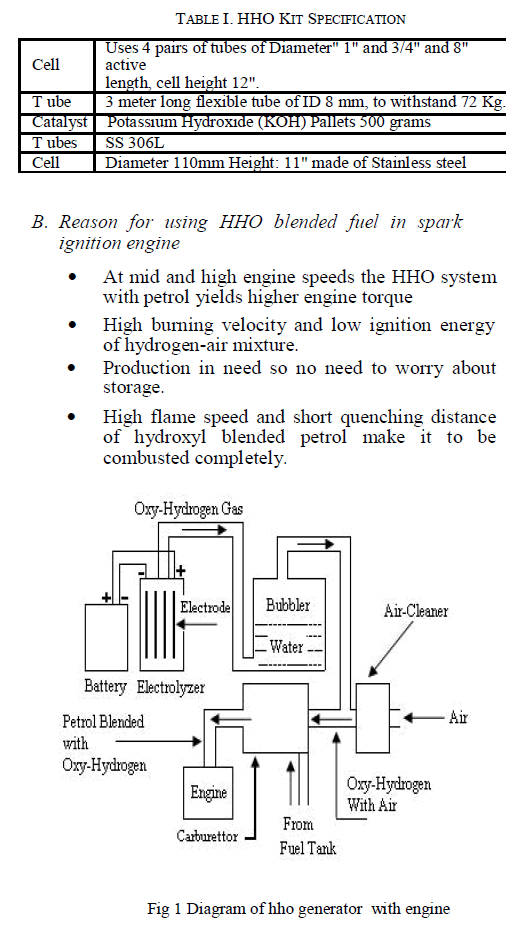 |
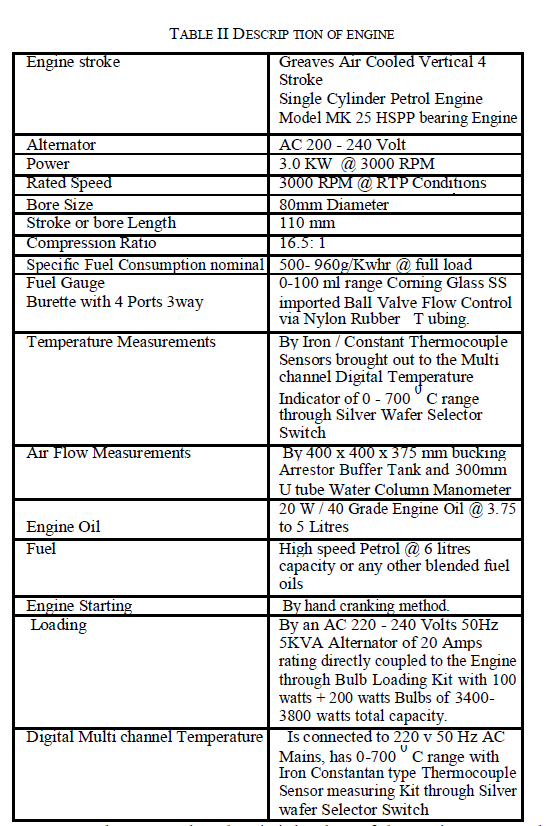 |
| A nozzle mounted to the air inlet duct of the engine was used to measure the air-flow rate. The pressure difference across the nozzle was measured with an accuracy of ±0.01 kPa using a U tube manometer. The amount of petrol used can be noted by noting the level indicated in the glass vertical tube. To measure the amount of fuel used as the engine runs the time taken for the usage of 10cc of fuel is noted using a stop watch. This gives the value of the fuel consumed for a particular time. |
| The experiment is carried out in two stages. The first stage is one in which we calculate the efficiency of the engine using the normal fuel. In the tabulation the time taken for 10cc fuel, the ammeter volt meter readings, the level of liquid in manometer are all noted. From these values using the formulae the brake thermal efficiency volumetric efficiency are calculated. |
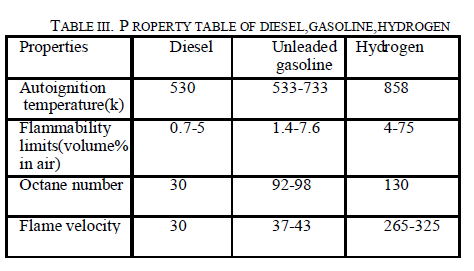 |
| Second phase is fitting the kit devised to the engine. The oxy-hydrogen producing kit is attached in the place between the air inlet and the carburettor. So the petroleum and the oxy-hydrogen will have enough time to blend. This blended fuel is send as inlet to the engine. Then the same readings are noted and its efficiency is calculated. A graph is drawn with both the efficiencies. By comparing the results we find out the efficiency increase in the usage of a electrolyser kit producing oxy hydrogen. |
| The setup we need to carry out the analysis of the efficiency of a engine using a blended fuel is a four stroke engine and the electrolyser apparatus which produce the oxy - hydrogen. |
| C. Setting of KIT |
| The setting of the kit to the already existing engine is as follows |
| • A hole is made on rubber air hose and fix elbow by applying araldite . |
| • It is placed and fixed on the engine vertically on appropriate place so that elbow of cell position upside. |
| • The electronic control unit connect red wire ignition positive. |
| • Black wire is connected to negative are on body earthing. |
| • Remain two yellow are to be connected on cell terminals. |
| • When switched ON air bubble is noticed in the cell. |
| D. Working |
| Fuel tank in the engine is filled with ordinary petrol. The engine is started using the rope crank mechanism, at no load condition. The amount of fuel consumed is noted by noting readings in the vertical glass tube. The time taken for the usage of a 10cc fuel is noted using a stop watch. The mano metric tube readings denoting the air pressure are noted. The ammeter, voltmeter readings are noted. These values are tabulated. Then the load is increased by switching on the bulbs. The readings are repeated for increased load. Then the efficiency is calculated for the same. |
| The brake thermal efficiency, indicated thermal efficiency, mechanical efficiency are all calculated using the formulae |
| Then the electrolyser kit is fixed to the engine. The time taken for 10cc fuel consumption, the air flow rate, the ammeter volt meter readings are all noted. The load is increased and the readings are taken. Efficiency is calculated with the formulas. |
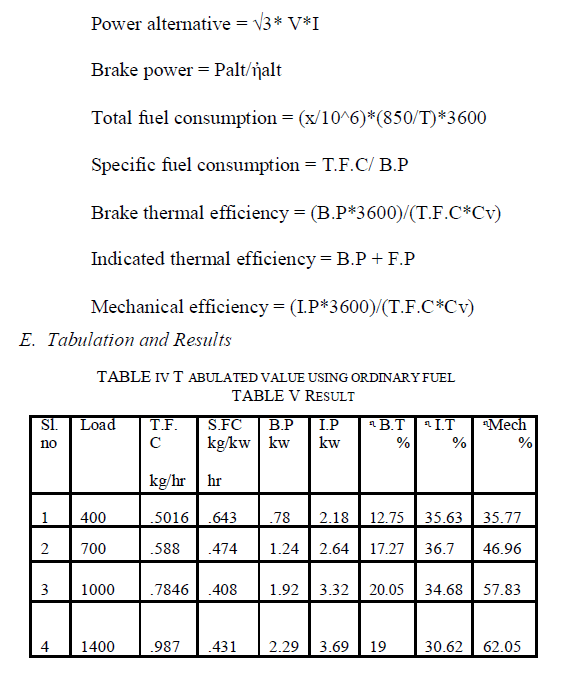 |
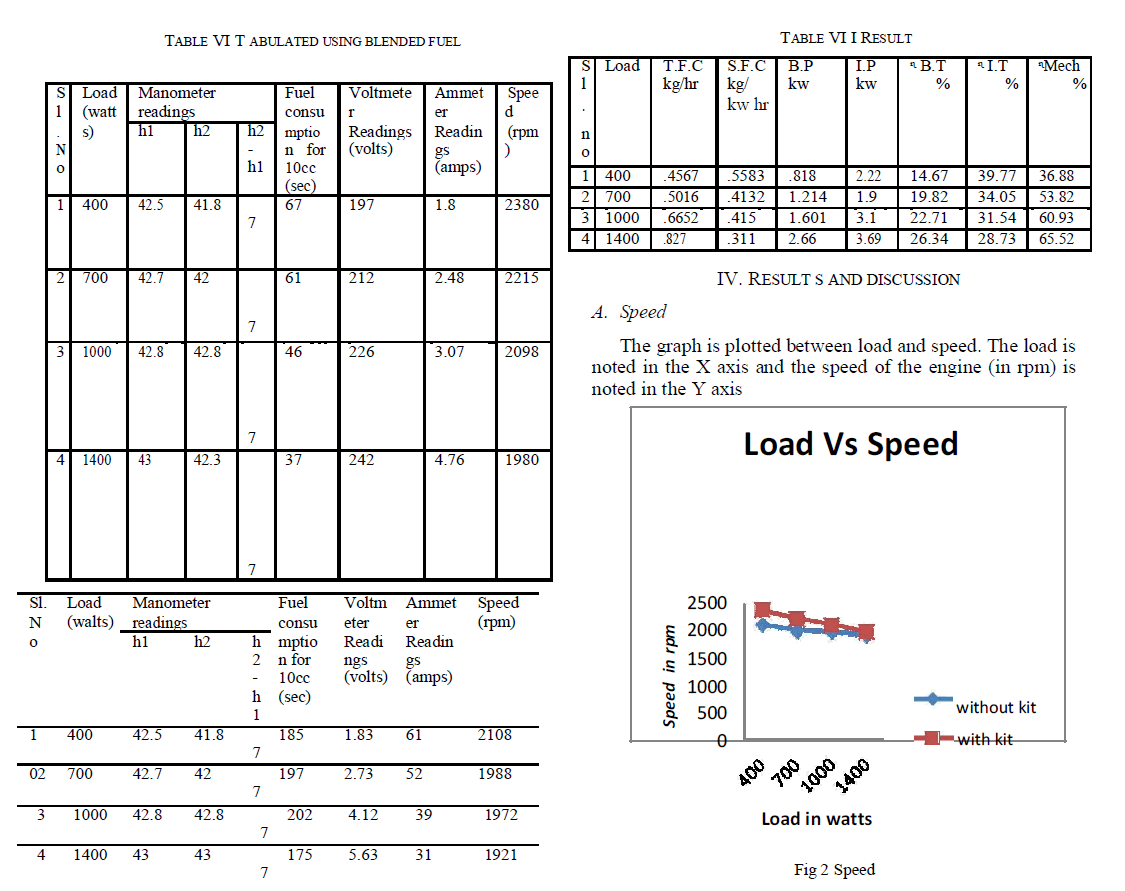 |
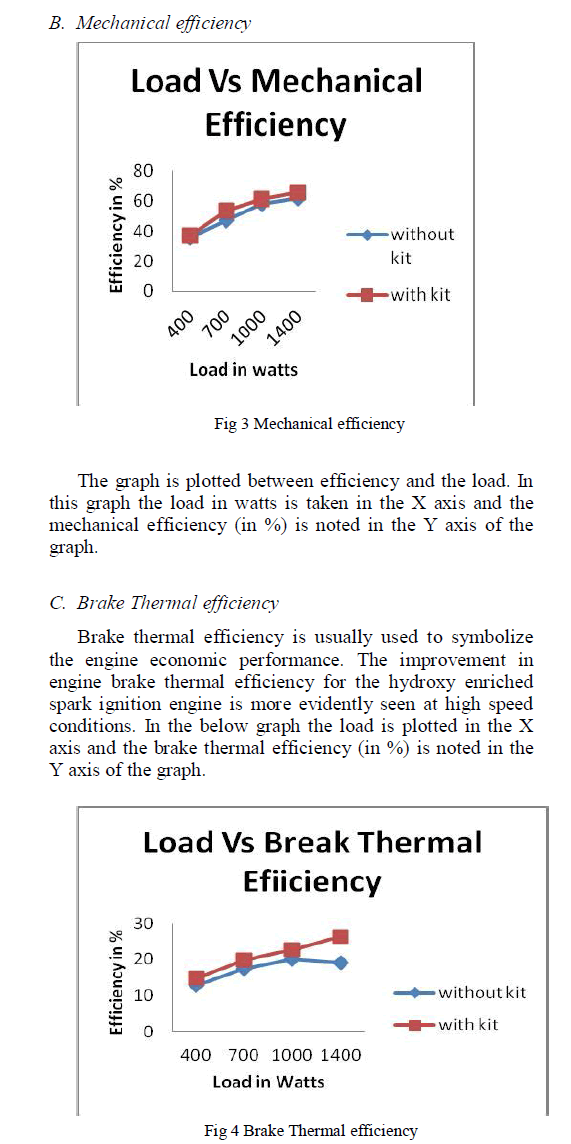 |
| the efficiency between using kit and without kit is shown in the graph |
| D. Total fuel consumption |
| T.F.C is the total fuel consumed. A graph is plotted between the total fuel consumed and the load. The graph is drawn for both the values of with and without kit in the same graph. So that it can be easy to find the change of values between them. |
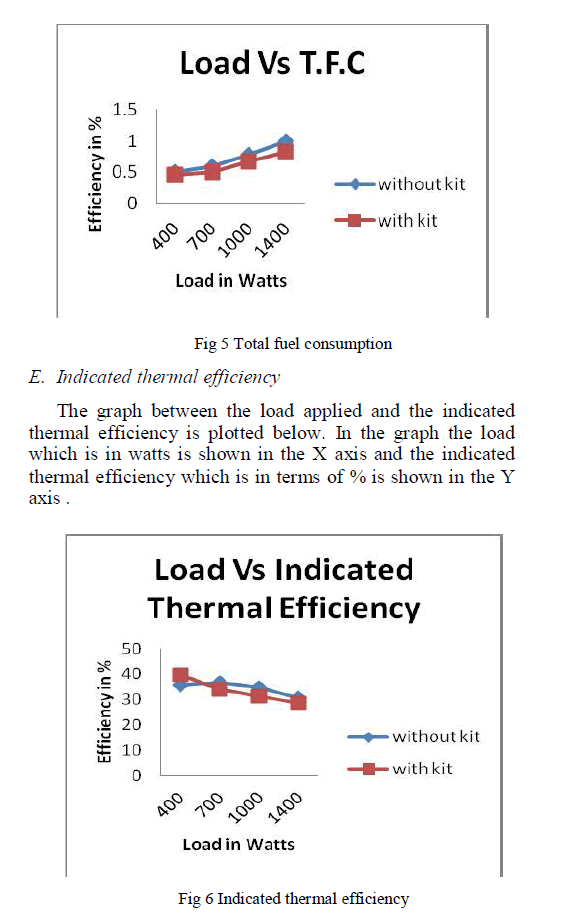 |
| At greater loads the break thermal efficiency of the ordinary fuel used engine drops steeply. But by using the blended fuel the efficiency does not drop. The difference in |
| F. Specific fuel consumption |
| The variation SFC with load is shown in the graph below. The load in watts is taken in the X axis and the specific fuel consumption which is in terms of kilogram per kilowatt hour is shown in the Y axis. |
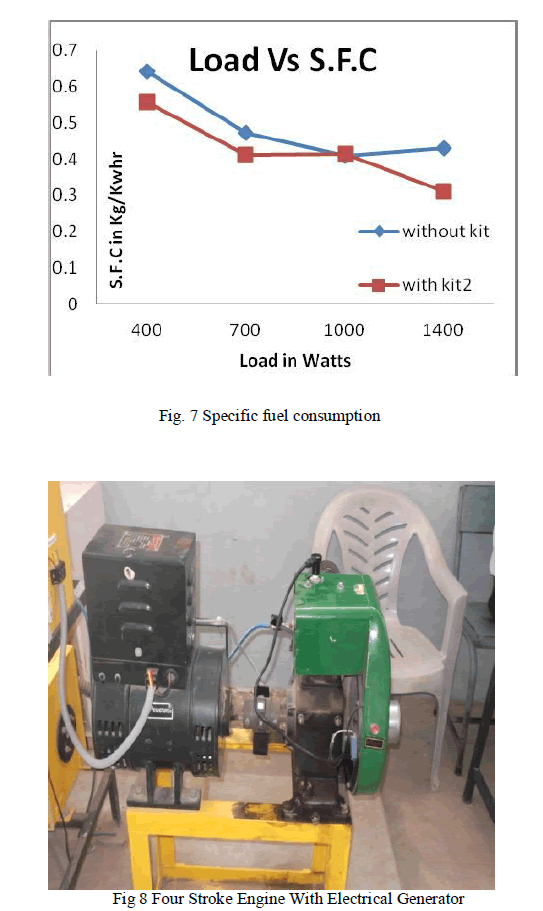 |
CONCLUSION |
| At mid and higher engine speeds; the HHO system with petrol fuel yields higher engine efficiency compared to pure petrol fuelled engine operation. Increased CR may cause pre-ignition and this can be minimized by direct HHO injection into the cylinder. Since minimum ignition energy of hydroxy air mixture is a decreasing function of equivalence ratio till stoichiometric (richer) conditions, torque is reduced after HHO gas addition. |
| • The results by using blended fuel has shown increased efficiency than using only normal petrol by 3 to 5%. |
| • Uniform and improved mixing of hydro -oxy and air stimulate combustion which has a major effect on SFC by using an adequate capacity system. Wide flammability range, high flame speed and short quenching distance of hydroxy yield petrol fuel to be combusted completely under high speed conditions. |
| • High burning velocity, wide flammability range, oxygen content and absence of carbon make HHO gas an appropriate fuel addition to obtain adequate combustion which yield reputable reduction of HC and CO emissions. |
| • Copper-coated engine showed improved performance when compared to conventional engine with both different test fuels. |
References |
|